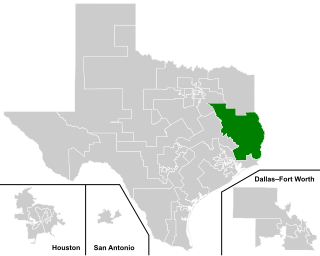
Liberty County is a county in the U.S. state of Texas. As of the 2020 census, its population was 91,628. The county seat is Liberty. It was founded in 1831, as a municipality in Mexico as Villa de la Santísima Trinidad de la Libertad by commissioner José Francisco Madero and organized as a county of the Republic of Texas in 1836. Its name was anglicized as Liberty based on the ideal of American liberty.

Cleveland is a city in the U.S. state of Texas, within the Greater Houston metropolitan area and Liberty County. The population was 7,471 at the 2020 census.

East Texas is a broadly defined cultural, geographic, and ecological region in the eastern part of the U.S. state of Texas that comprises most of 41 counties. It is primarily divided into Northeast and Southeast Texas. Most of the region consists of the Piney Woods ecoregion. East Texas can sometimes be defined only as the Piney Woods. At the fringes, towards Central Texas, the forests expand outward toward sparser trees and eventually into open plains.

Texas's 8th congressional district of the United States House of Representatives includes all of Polk and San Jacinto counties, and parts of Harris, Walker, and Montgomery counties. It includes much of the northern outlying areas of metro Houston, including Conroe, Magnolia, and most of Lake Livingston. The current Representative from the 8th district is Morgan Luttrell and has been since 2023.

The Big Thicket is the name given to a somewhat imprecise region of a heavily forested area of Southeast Texas in the United States. This area represents a portion of the mixed pine-hardwood forests or "Piney Woods" of the Southeast US. The National Park Service established the Big Thicket National Preserve (BTNP) within the region in 1974 and it is recognized as a biosphere reserve by UNESCO. Although the diversity of animals in the area is high for a temperate zone with over 500 vertebrates, it is the complex mosaic of ecosystems and plant diversity that is particularly remarkable. Biologists have identified at least eight, and up to eleven, ecosystems in the Big Thicket area. More than 160 species of trees and shrubs, 800 herbs and vines, and 340 types of grasses are known to occur in the Big Thicket, and estimates as high as over 1000 flowering plant species and 200 trees and shrubs have been made, plus ferns, carnivorous plants, and more. The Big Thicket has historically been the most dense forest region in Texas.

District 3 of the Texas Senate is a senatorial district that serves all of Anderson, Angelina, Cherokee, Hardin, Henderson, Houston, Jasper, Liberty, Nacogdoches, Newton, Orange, Polk, Sabine, San Augustine, Shelby, Trinity, and Tyler counties, and a portion of Jefferson county in the U.S. state of Texas. The current senator from District 3 is Robert Nichols.

Area codes 713, 281, 832, and 346 are telephone area codes in the North American Numbering Plan (NANP) forming an overlay complex for Houston, Texas and its environs. 713 is one of the original four area codes established for Texas in 1947.

Area code 409 is a telephone area code in the North American Numbering Plan (NANP) for the U.S. state of Texas. The numbering plan area comprises the Beaumont and Galveston areas. It was created on March 19, 1983, in an area code split of area code 713, the first since 619 split from 714 four months earlier. Initially, it consisted of a horseshoe-shaped area that almost completely surrounded Houston, but in 2000 it was divided into three sections. Area code 409 was retained by the eastern segment, while the central portion, centered on Nacogdoches, received area code 936 and the western portion centered on Bryan–College Station, was assigned area code 979.

State Highway 321 is a north–south highway in southeastern Texas, starting at US 90 in Dayton and ending at Loop 573 in Cleveland. The route was designated on October 30, 1939.
Tarkington Prairie is a primarily rural unincorporated community spread out over approximately 238 square miles (620 km2) in northeastern Liberty County, Texas, United States. The community's fire protection is provided by Tarkington Volunteer Fire Department, emergency medical services by Liberty County EMS, and law enforcement by Liberty County Sheriff's Office.

The Texian Army, also known as the Revolutionary Army and Army of the People, was the land warfare branch of the Texian armed forces during the Texas Revolution. It spontaneously formed from the Texian Militia in October 1835 following the Battle of Gonzales. Along with the Texian Navy, it helped the Republic of Texas win independence from the Centralist Republic of Mexico on May 14, 1836 at the Treaties of Velasco. Although the Texas Army was officially established by the Consultation of the Republic of Texas on November 13, 1835, it did not replace the Texian Army until after the Battle of San Jacinto.

The Star of the Republic Museum, in Washington, Texas, United States, is the only museum in the state of Texas created specifically to collect and interpret the culture and history of the Republic of Texas from 1836 to 1846. Within the museum's two floors of exhibits, visitors can learn about the history of the time period through media experiences, as well as informative exhibits. The site of the Star of the Republic Museum was selected at Washington on the Brazos where elected delegates gathered on March 2, 1836, to declare Texas’ independence from Mexico.

The 1996 United States presidential election in Texas took place on November 5, 1996. All fifty states, and the District of Columbia, took part in the 1996 United States presidential election. State voters chose 32 electors to the Electoral College, which selected the president and vice president.












